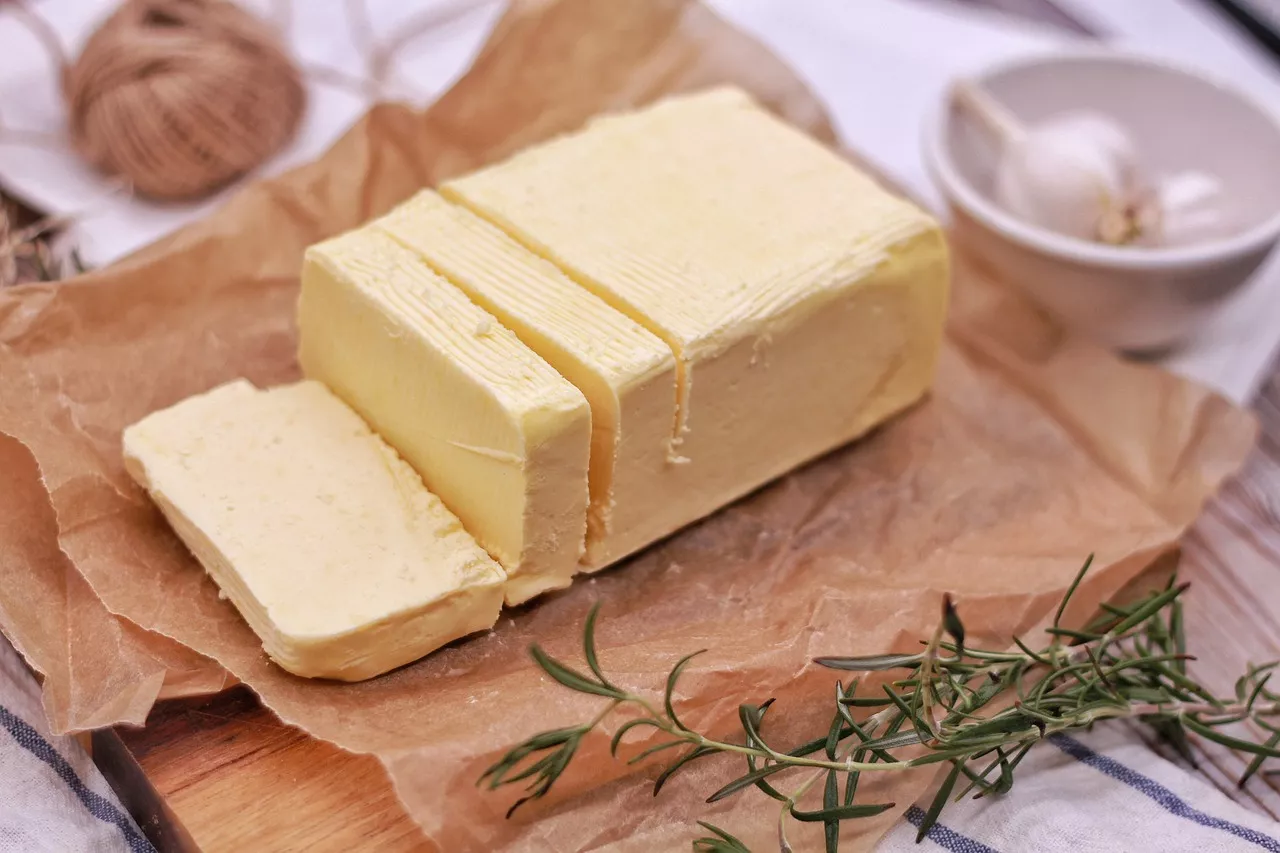Why freeze butter?
Freezing butter is a great way to extend its shelf life and prevent it from going to waste. Whether you have an abundance of butter or want to stock up during a sale, freezing is a convenient option. Butter can last for several months in the freezer without losing its quality or flavor. By freezing butter, you can have it on hand whenever you need it, without worrying about it spoiling.
Butter is a versatile ingredient that adds richness and flavor to a wide range of dishes, from baked goods to savory recipes. Freezing butter allows you to have it readily available for whenever inspiration strikes. Whether you're whipping up a batch of cookies or sautéing vegetables, having frozen butter at your disposal can make the cooking process smoother and more enjoyable.
When it comes to freezing butter, there are a few things to keep in mind. Let's explore the proper method to freeze butter and ensure it stays fresh and flavorful.
How to properly freeze butter
Freezing butter is a straightforward process that requires minimal effort. Here's a step-by-step guide on how to properly freeze butter:
1. Start by selecting the butter you want to freeze. Whether you prefer salted or unsalted butter, both can be frozen with excellent results. Ensure that the butter is fresh and free from any mold or off-flavors.
2. If the butter is in its original packaging, you can freeze it as is. However, if you have opened a stick of butter, it's best to wrap it tightly in plastic wrap or aluminum foil. This will protect the butter from freezer burn and prevent it from absorbing any unpleasant odors.
3. For additional protection, consider placing the wrapped butter in a sealable freezer bag or airtight container. This extra layer will further safeguard the butter from freezer burn and help maintain its quality.
4. Label the package with the date of freezing to keep track of its freshness. Butter can be stored in the freezer for up to six months, but it's best to use it within three to four months for the best flavor.
By following these simple steps, you can ensure that your butter remains fresh and ready to use whenever you need it. Now, let's delve into some tips for storing frozen butter to maintain its quality.
Tips for storing frozen butter
Proper storage is crucial to maintaining the quality and flavor of frozen butter. Here are some tips to help you store your frozen butter effectively:
1. Keep the temperature consistent: Ensure that your freezer maintains a constant temperature of 0°F (-18°C) or below. Fluctuating temperatures can lead to freezer burn and affect the quality of the butter.
2. Store butter away from strong-smelling foods: Butter can absorb odors from other foods in the freezer, affecting its flavor. To prevent this, store butter away from strong-smelling foods, such as onions or fish.
3. Use small portions: If you frequently use small amounts of butter, consider dividing a stick into smaller portions before freezing. This way, you can thaw only what you need, minimizing waste and ensuring the remaining butter stays frozen.
4. Rotate your stock: To ensure you always have the freshest butter on hand, practice the "first in, first out" principle. Use the oldest frozen butter first and replace it with a fresh batch when needed.
By following these storage tips, you can maintain the quality of your frozen butter and enjoy its rich flavor in all your culinary creations. Speaking of which, let's explore some delicious recipes that incorporate frozen butter.
How long can you freeze butter?
One of the most common questions about freezing butter is how long it can be stored in the freezer. Butter can be safely kept in the freezer for up to six months. However, for the best flavor and quality, it is recommended to use frozen butter within three to four months.
While frozen butter can technically be stored for longer, it may begin to develop off-flavors and lose some of its richness over time. By using the butter within the suggested timeframe, you can ensure that it retains its optimal flavor and texture.
It's important to note that freezing butter does not kill any bacteria present in the original product. Therefore, it's crucial to start with fresh, high-quality butter to minimize the risk of any potential foodborne illnesses. Always check the butter for any signs of spoilage before freezing and discard if necessary.
Thawing frozen butter
Thawing frozen butter is a simple process that can be done in various ways, depending on your needs. Here are a few methods for thawing frozen butter:
1. Refrigerator thawing: The easiest and safest way to thaw frozen butter is by transferring it from the freezer to the refrigerator. Place the wrapped butter or container in the refrigerator and allow it to thaw slowly overnight or for approximately 8-12 hours. Thawing butter in the refrigerator ensures a gradual thaw, maintaining its quality and reducing the risk of bacterial growth.
2. Room temperature thawing: If you need to thaw butter quickly, you can do so at room temperature. Remove the wrapped butter from the freezer and let it sit at room temperature for about 30 minutes to an hour. The butter should soften but still be cool to the touch. Be cautious not to leave it out for too long to avoid melting or compromising its quality.
3. Grating frozen butter: If you need softened butter for a recipe, but only have frozen butter on hand, grating the frozen butter can help speed up the softening process. Use a box grater or a food processor fitted with a grating attachment to grate the frozen butter into small, manageable pieces. The grated butter will soften more quickly than a whole stick, allowing you to incorporate it into your recipe with ease.
Regardless of the thawing method you choose, it's important to note that once butter has been thawed, it cannot be refrozen. Always thaw only the amount of butter you need to avoid waste and ensure the best quality.
Using frozen butter in recipes
Frozen butter can be used in a wide variety of recipes, from flaky pastries to creamy sauces. Here are a few ways you can incorporate frozen butter into your favorite dishes:
1. Baking: Frozen butter is a go-to ingredient for creating flaky pastries and baked goods. Whether you're making pie crusts, scones, or biscuits, incorporating frozen butter into the dough creates layers and contributes to a light and tender texture. Grate the frozen butter directly into the dry ingredients and mix until the butter is evenly distributed.
2. Sauces and gravies: Frozen butter can add richness and silky texture to sauces and gravies. When making a sauce or gravy, add small pieces of frozen butter gradually, whisking constantly until the sauce thickens and becomes glossy. The frozen butter will melt slowly, emulsifying the sauce and creating a velvety finish.
3. Roasting vegetables: For extra flavor and a beautiful golden finish, place small pieces of frozen butter on top of vegetables before roasting them. As the butter melts, it will coat the vegetables, enhancing their natural sweetness and adding a delicious richness.
4. Compound butter: Frozen butter is perfect for making compound butters, which are flavored butters used to enhance the taste of various dishes. Grate frozen butter and mix it with herbs, spices, or citrus zest to create a versatile and flavorful compound butter. Use it to top grilled meats, vegetables, or spread it on bread for an extra kick of flavor.
These are just a few examples of how frozen butter can elevate your culinary creations. Don't be afraid to experiment and discover new ways to incorporate frozen butter into your favorite recipes.
Common concerns and misconceptions about freezing butter
When it comes to freezing butter, there are a few common concerns and misconceptions that often arise. Let's address some of these to ensure you have all the information you need:
1. Can you freeze salted and unsalted butter? Both salted and unsalted butter can be safely frozen. The freezing process does not affect the flavor or texture of either type of butter. Choose the type of butter based on your personal preference and the specific recipe you'll be using it in.
2. Does freezing butter affect its quality? When frozen and stored correctly, butter maintains its quality and flavor. However, it's important to use the butter within the recommended timeframe (three to four months) for the best results. Beyond that, the butter may start to lose some of its flavor and develop off-flavors.
3. Can you freeze butter in its original packaging? If the butter is in its original packaging and will be used within the recommended timeframe, it can be safely frozen as is. However, if you have opened a stick of butter, it's best to wrap it tightly in plastic wrap or aluminum foil to protect it from freezer burn.
4. Can you freeze whipped butter? Whipped butter is not recommended for freezing as the texture and consistency will be altered. It's best to freeze solid butter and use it as needed.
By addressing these concerns and misconceptions, you can feel confident in your ability to freeze butter effectively and enjoy its benefits.
Frequently asked questions about freezing butter
Q: Can I freeze butter in bulk? A: Yes, you can freeze butter in bulk. Simply wrap the butter tightly and place it in an airtight container or freezer bag for long-term storage.
Q: Can I freeze butter in a glass container? A: While it is possible to freeze butter in a glass container, it's important to ensure that the container is freezer-safe and can withstand the low temperatures without breaking. Check the manufacturer's guidelines before freezing butter in a glass container.
Q: Can I freeze butter in parchment paper? A: Freezing butter directly in parchment paper is not recommended as it may not provide sufficient protection against freezer burn. It's best to wrap the butter in plastic wrap or aluminum foil before freezing.
Q: Can I freeze butter that has already been melted? A: It is not recommended to freeze butter that has been melted and then cooled. The texture and consistency of the butter may be altered, resulting in a less desirable product.
Q: How can I tell if frozen butter has gone bad? A: Frozen butter that has gone bad may develop off-flavors, an unpleasant odor, or mold. Always check the butter for any signs of spoilage before using it, and discard if necessary.
By addressing these frequently asked questions, you can gain a deeper understanding of freezing butter and make informed decisions when it comes to storing and using it.
Alternative methods for preserving butter
Freezing butter is not the only method for preserving it. Here are a few alternative methods you can explore:
1. Canning: Canning butter involves processing it in glass jars at high temperatures to create a seal. This method can extend the shelf life of butter for up to a year or more. However, canning butter requires specialized equipment and knowledge of canning procedures, so it may not be suitable for everyone.
2. Clarified butter: Clarified butter, also known as ghee, is butter that has had its milk solids removed. Clarified butter has a longer shelf life than regular butter and does not require refrigeration. It can be stored at room temperature for several months. The process of clarifying butter involves melting it and separating the clear liquid from the milk solids, resulting in a pure, golden liquid.
3. Butter crocks: A butter crock, also known as a butter bell, is a traditional method of storing butter at room temperature. The butter is placed in a bell-shaped container, which is then filled with water. The water creates a seal, preventing air from reaching the butter and keeping it fresh. This method allows you to keep butter soft and spreadable without refrigeration for up to a week.
These alternative methods offer different ways to preserve and store butter, depending on your preferences and needs. Consider exploring these options to find the one that works best for you.
Conclusion
Freezing butter is a simple and effective way to extend its shelf life and ensure that it never goes to waste. By following the proper freezing and storage methods, you can enjoy the convenience of having butter readily available whenever you need it. Whether you're baking a batch of cookies or sautéing vegetables, frozen butter can enhance the flavor and texture of your dishes. Remember to use high-quality butter, label your packages, and rotate your stock to ensure the best results. With the knowledge gained from this ultimate guide, you're now equipped to freeze butter like a pro. Say goodbye to wasted butter and hello to endless culinary possibilities!

 Delicious Recipes with Honey for Every Palate
Delicious Recipes with Honey for Every Palate 5 Creative Ways to Enjoy Avocado
5 Creative Ways to Enjoy Avocado



